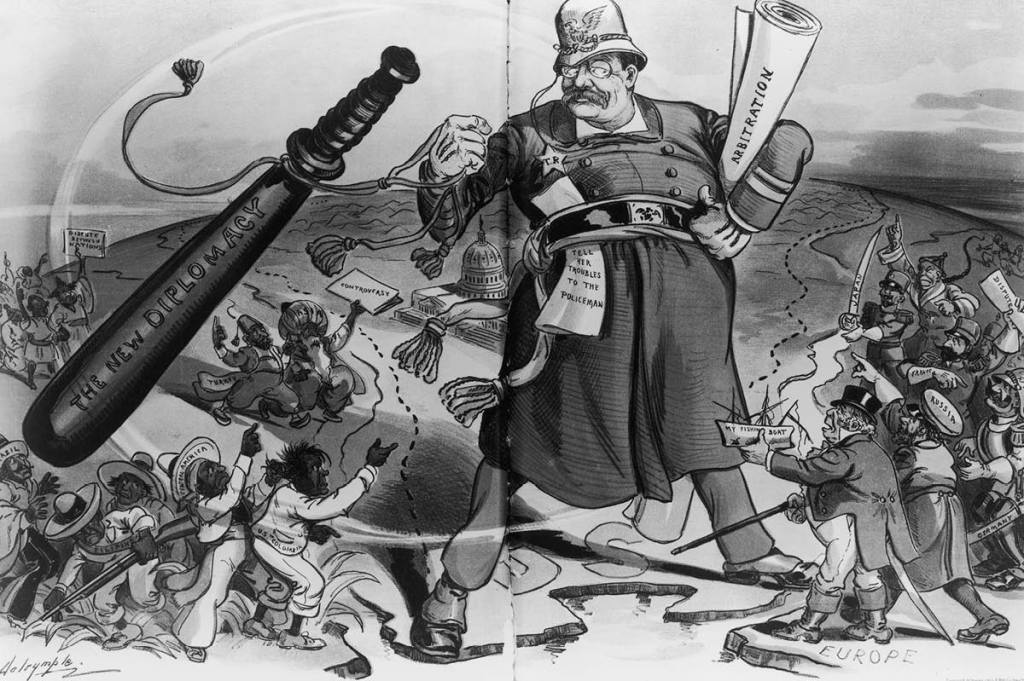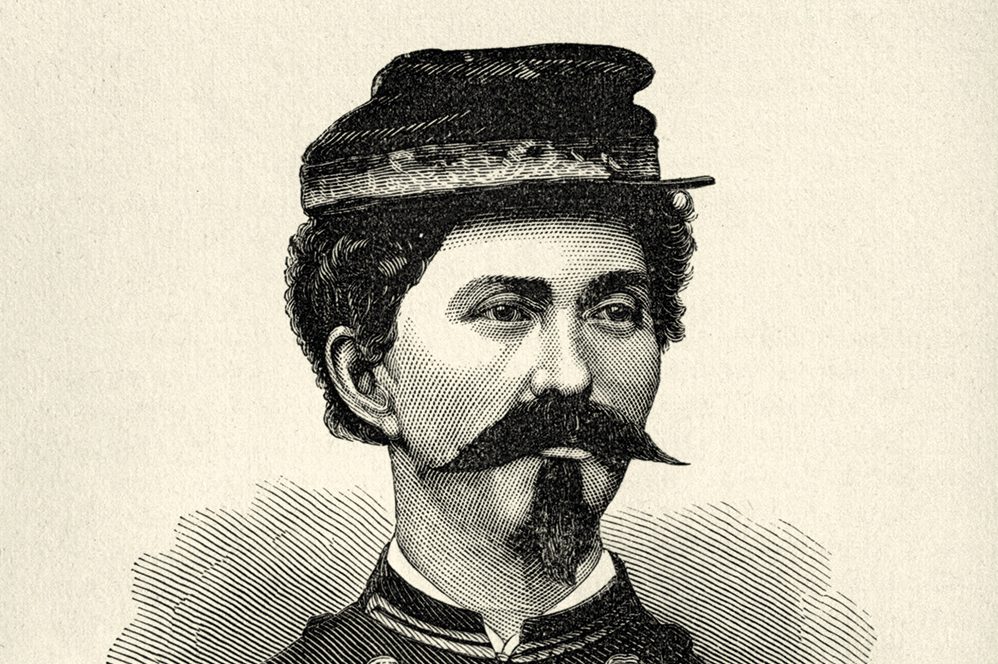Nowadays few Americans could identify what the Monroe Doctrine signifies. Named for the fifth US president, the point of the 1823 policy had been succinctly stated fifteen years earlier by the third, Thomas Jefferson: “The object… must be to exclude all European influence from this hemisphere.”
Sean Mirski terms the Doctrine “revolutionary” in his impressively erudite We May Dominate the World, an astonishingly comprehensive and stylishly written account of US foreign policy in the Western Hemisphere during the years 1860 to 1945. Calling the period a “missing chapter” in American history, he rightly asserts that “the story of the United States’s rise to regional hegemony has not received anywhere near the attention it deserves.”
France’s 1861-67 invasion of Mexico — a piece of history even well-read American historians may not immediately recall — understandably led to “a new, nationwide commitment to the Monroe Doctrine” once the US reunified in the wake of the Civil War. “For the sake of its own security, the United States needed to help stabilize and strengthen its neighbors” in order “to prevent unstable parts of the Western Hemisphere from falling into the hands of its great-power rivals.”
Throughout the late nineteenth century pressures mounted as Great Britain, France and Germany all aggressively expanded their colonial empires, and Mirski recounts how, by early in the twentieth century, colonial powers controlled more than 80 percent of the world’s landmass. Up until the late 1890s the United States was content to employ attentive deterrence, but a confrontation between Great Britain and Venezuela, plus increasing Japanese pressure on the independent kingdom of Hawaii, led to a decisive shift in US behavior and the adoption of a “far more assertive” Monroe Doctrine. “Over time, the defensive strategy of European exclusion turned into the reality of aggressive American expansion” as the United States went on what Mirski claims was “a regional rampage of staggering scope and scale,” intervening in one manner or another from Haiti, the Dominican Republic and Cuba in the Caribbean to Panama, Nicaragua, Honduras and Mexico in Central America as well as in Hawaii.
That is one of few occasions when Mirski’s energetic style gets the better of his considered judgment, for as he later forthrightly acknowledges, almost always the US “had no good options. If one of its neighbors imploded, the United States could not safely ignore the resulting power vacuum for fear that one of its great-power rivals might step in.” Such was the case both in Hawaii in 1897-98 and in Panama — then a province of Colombia — in 1903, the two interventions that would loom largest in subsequent American history.
As imperial Japan expanded its appetite for possessions across both East Asia and the northern Pacific, “it increasingly seemed like the only way the United States could prevent Hawaii from falling into Tokyo’s hands was by grabbing it first.” Thus the US forcibly annexed Hawaii “so Japan could not.” Then the brief Spanish-American War of 1898 over Cuba resulted in US annexation of both Puerto Rico in the Caribbean and Guam in the Pacific — plus the purchase of the Philippines for $20 million — but the 1903 US-sponsored Panamanian revolution, aimed at exerting direct control of the partially-dug Isthmian canal, would have far greater con- sequences, marking “a pivotal moment in the rise of the United States.” Eleven years later the world-changing canal would finally open.
After 1898, all across Latin America the United States “began protecting its neighbors primarily from themselves” rather than from imperialistic European powers. In 1904 President Theodore Roosevelt memorialized that change of emphasis in what would be called the Roosevelt Corollary to the Monroe Doctrine: domestic instability, he announced, “may force the United States, however reluctantly… to the exercise of an international police power” to restore order in Western Hemisphere states. Yet Roosevelt himself, notwithstanding his Spanish-American War record as a “rough rider” cavalryman, reserved US intervention only “as a last resort.”
Roosevelt’s ill-chosen successor, William Howard Taft, proved dramatically different; a 1909 coup in Nicaragua would mark the first time the US “openly toppled a foreign government,” and US Marines would remain there until 1933. Taft’s Democratic successor, the studiously pious Woodrow Wilson, saw himself as decidedly anti-imperialist, but ended up quickly topping Taft’s record as regional discord spread. Notwithstanding what Mirski acknowledges was “the often extreme reluctance of American officials to use force in the region,” come 1917, “on the eve of its entry into World War One, the United States was intervening across the hemisphere as never before,” he accurately writes.
Ironically, it was World War One itself — which left every major world power except the United States badly bloodied and weak- ened — that ultimately allowed the US to relax its grip on its often-troubled neighbors. Future president Herbert Hoover coined a memorable name for the new stance, but it was State Department diplomat Sumner Welles who actually “masterminded the withdrawals” as the US “stood down and transitioned to the Good Neighbor Policy.” Behind the scenes, Welles would craft multiple landmark American foreign policy initiatives before being forced out of government as a gay man with a predilection for interracial sex.
We May Dominate the World is a work of prodigious scholarship, featuring an extraordinary breadth and depth of sources, vastly more than one nowadays sees in most books written by young PhD historians. What’s all the more remarkable is that Mirski is a practicing attorney, with a seemingly full-time day job at the storied Washington firm of Arnold and Porter. Mirski’s author’s biography — unlike his law firm page — omits his stellar record at Harvard Law School and his clerkships for now-Justice Brett M. Kavanaugh as well as Justice Samuel A. Alito Jr. Yet Mirski is clearly no conservative ideologue, but a foreign policy intellectual who, still in his early thirties, has also worked in the upper reaches of the US Defense Department.
Mirski’s splendid book shares a clear spirit with works such as Philip H. Gordon’s Losing the Long Game: The False Promise of Regime Change in the Middle East (2020) and Steven Simon’s Grand Delusion: The Rise and Fall of American Ambition in the Middle East (2023), even though a century in time and half a world of distance ostensibly distinguish these titles. “Stabilizing failed or failing states was a monumental task without any easy fixes,” Mirski writes, and “external intervention, almost by its very nature, undermines a country’s long-term stability” since it is “inherently difficult for outsiders to impose the kinds of institutions needed for long-term stability.” Americans might easily think of Vietnam as well as Iraq and Afghanistan when reading these words, but even back during the Wilson administration the United States was repeatedly guilty of “foisting elections on nations that were culturally, socially and institutionally ill-prepared for them.”
The world’s most essential columnist, Walter Russell Mead, recently observed in the Wall Street Journal that “the security and prosperity of our neighborhood matters enormously to the US, but Latin America has been at most an afterthought in American foreign policy since the end of the Cold War.” Mead is surely correct, but that detracts not one whit from the value and originality of We May Dominate the World — Mirski rightly suggests that the strategy of “containment” employed against the Soviet Union from 1947 until the USSR’s collapse was in practice “a global Monroe Doctrine,” as a then little-known senator from Delaware put it in 1976.
Mirski seeks to reach beyond that Biden-esque insight by contending that “the issues the United States confronted” in Latin America in the early twentieth century “remain startlingly contemporary,” for “rising powers… can and often will be driven to expansion and aggression.” Yet he seems to clearly realize that his brief concluding effort to draw parallels with the current behavior of the Chinese Communist Party feels forced if not overstated.
“China’s foreign policy has begun to echo the policies followed by a rising United States over a century ago,” Mirski asserts, but the readily apparent differences between the two situations appear vastly greater than any surface similarities. Even as the White House changed hands almost every four years from the 1860s into the 1930s, the US, more often than not, drew back from aggressive military action, whereas today’s one-man Chinese dictatorship features an increasingly well-armed and aggrieved nationalism that is vastly more dangerous to its neighbors than anything the Western Hemisphere witnessed at the turn of the prior century.
Yet this brief overreach in no way substantively detracts from a deeply valuable work of original scholarship that brings vividly to life an important and all but forgotten age of American history.
This article was originally published in The Spectator’s August 2023 World edition.

























